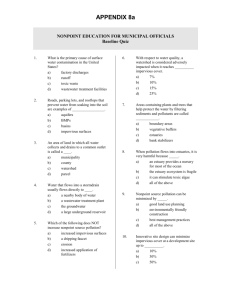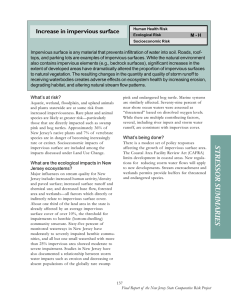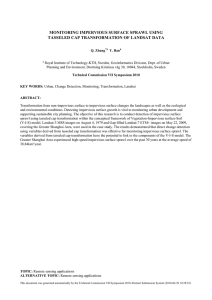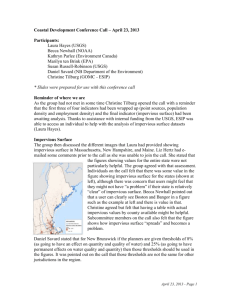Considerations for Decision-making: Human Impacts Estimated PopuLation Density
advertisement
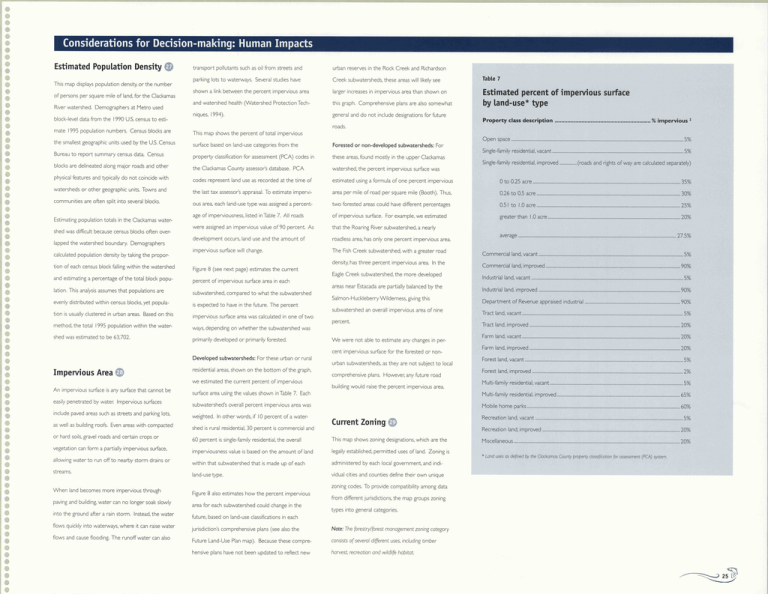
Considerations for Decision-making: Human Impacts Estimated PopuLation Density This map dispays popuIatan density, or the number of persons per square mile of land, for the Clackamas River watershed. Demographers at Nietro used block-level data from the I 990 U.S. census to estimate I 995 population numbers. Census blocks are the smallest geographic units used by the U.S. Census Bureau to report summary census data. Census blocks are delineated along major roads and other physical features and typically do not coincide with watersheds or other geographic units. Towns and communities are often split into several blocks. Estimating population totals in the Clackamas watershed was difficult because census blocks often over- lapped the watershed boundary Demographers calculated population density by taking the proportion of each census block falling within the watershed and estimating a percentage ofthe total block population. This analysis assumes that populations are evenly distributed within census blocks, yet population is usually clustered in urban areas. Based on this method, the total I 995 population within the watershed was estimated to be 63,702. transport pollutants such as oil from streets and urban reserves in the Rock Creek and Richardson parking lots to waterways. Several studies have Creek subwatersheds, these areas will likely see TabLe 7 shown a link between the percent impervious area larger increases in impervious area than shown on and watershed health (Watershed Protection Tech- this graph. Comprehensive plans are also somewhat Estimated percent of impervious surface by Landuse* type niques, I 994). general and do not include designations for future Property class description This map shows the percent oftotal impervious surface based on land-use categories from the Forested or non-developed subwatersheds: For property classification for assessment (RCA) codes in these areas, found mostly in the upper Clackamas as well as building roofs. Even areas with compacted or hard soils, gravel roads and certain crops or vegetation can form a partially impervious surface, allowing waterto run offto nearby storm drains or streams. When land becomes more impervious through paving and building, water can no longer soak slowly into the ground after a rain storm. Instead, the water flows quickly into waterways, where it can raise water flows and cause flooding. The runoffwater can also E 0/ J /0 (roads and rights ofway are calculated separately) codes represent land use as recorded at the time of estimated using a formula ofone percent impervious 0 to 0.25 acre 35% the last tax assessor's appraisal. To estimate impervi- area per mile of road per square mile (Booth). Thus, 0.26 to 0.5 acre 30% ous area, each land-use type was assigned a percent- two forested areas could have different percentages 0.5 I age ofimperviousness, listed inTable 7. All roads of impervious surface. For example, we estimated greater than I .0 acre were assigned an impervious value of9O percent. As that the Roaring River subwatershed, a nearly development occurs, land use and the amount of roadless area, has only one percent impervious area. impervious surface will change. The Fish Creek subwatershed, with a greater road density, has three percent impervious area. In the Figure 8 (see next page) estimates the current Eagle Creek subwatershed, the more developed percent of impervious surface area in each areas near Estacada are partially balanced by the subwatershed, compared to what the subwatershed Salmon-HuckleberryWilderness, giving this is expected to have in the future. The percent subwatershed an overall impervious area of nine impervious surface area was calculated in one of two percent. ways, depending on whether the subwatershed was primarily developed or primarily forested. We were not able to estimate any changes in per- residential areas, shown on the bottom ofthe graph, comprehensive plans. However any future road we estimated the current percent of impervious include paved areas such as streets and parking lots, Single-family residential, vacant watershed, the percent impervious surface was urban subwatersheds, as they are not subject to local easily penetrated by water Impervious surfaces 5% Single-family residential, improved Developed subwatersheds: For these urban or rural An impervious surface is any surlace that cannot be Open space the Clackamas County assessor's database. RCA cent impervious surface forthe forested or non- Impervious Area ) % impervious 2 roads. building would raise the percent impervious area. to I .0 acre average Commercial land, vacant Commercial land, improved Industrial land, vacant 25% 20% 27.5% 5% 90% 5% Industrial land, improved 90% Department of Revenue appraised industrial 90% Tract land, vacant 5% Tract land, improved 20% Farm land, vacant 20% Farm land, improved 20% Forest land, vacant 5% Forest land, improved 2% Multi-family residential, vacant 5% surface area using the values shown inTable 7. Each Multi-family residential, improved 65% subwatershed's overall percent impervious area was Mobile home parks 60% weighted. In other words, if I 0 percent of a watershed is rural residential, 30 percent is commercial and Current Zoning 60 percent is single-family residential,the overall This map shows zoning designations, which are the imperviousness value is based on the amount of land legally established, permitted uses of land. Zoning is within that subwatershed that is made up of each administered by each local government, and mdi- land-use type. vidual cities and counties define their own unique zoning codes. To provide compatibility among data Figure 8 also estimates how the percent impervious from different jurisdictions, the map groups zoning area for each subwatershed could change in the types into general categories. future, based on land-use classifications in each jurisdiction's comprehensive plans (see also the Note: The forestry/forest management zoning category Future Land-Use Plan map). Because these corn pre- consists ofsevera/ different uses, inc/uding timber hensive plans have not been updated to reflect new harvest, recreation and wi/d/ife habitat. Recreation land, vacant 5% Recreation land, improved 20% Miscellaneous 20% * Land uses as defined by the Clackamas County property classification for assessment (PCA) system. IIiiu rir. It! II Mt Scott HaPPYVaRkj. Ii.', T Iu!rrn . - J jiT1 I4' lackamasRwer Population Density Est '- I :.'. - RC jiia i: _\ 600 NORTHEAST GRAND AVENUE ( iuifi1, . ; ,___._,__-____ U i'T -F : '(I t.. Eagle Creek f_/_________________" --- I' Nul1 '7 lit '(1 J9 -.ThtI_/' CLACKAMAS CO.'s MARION CO. Co ; ' 1' ' 7 1i(J Iq.* ,f1 ': 77r I 's,,"7t k d44 N I I Cttamas ;:e I : Roaring River \ ''n C' R '. C/aCm9SThV .\ E::::h:::1 / &: '\Ai f\ 4c H Persons perSquare Mile RrnM,y FAX 503 797 1909 $\ 0 1? LEGEND CTIYUMII3 PtId PORTLAND, OREGON 97232 2736 TEL 603 797 1742 - Salmon FERN . Overl000 , ° ' LR0 S s) Crc k lr- t_ .. tJ1'' Deep Creek I .- ! . ARD Je ° ! I 44 pVerCiackamas River '/ ¶\I1PdIIIi% ' s Cot/awash River I" J( ' I . 4* W+! E I_ ;: 24__ WOlF ThUS MAP IS INtENDED TO RE USED TU71IER WItH 7315 CORRESPONDING IEXTJNCLUDED IN tilE CIJ.CXAMASRIVER WAIFREHEDAThAS Scale in Miles " fr. '$% 1 # r ' ; "\ lL ' AI1Ø ( I I (*r S'- : !' h &_ WestLi Ik mi i1ItoR* j :I- It __u.ur NARDS R0 O 1 Goos 1. ,;' Eagle Creek LiV.r . Impervious 44' , sM ETR 0 ,? \r c:e&d!wA!!LIL % '. salmon * S , .t )) Roan I S Roafng7r 4h MI t_t, W 600 N0RTHEASTGRANDAvENuEP:RTLA:D0RE:oN 97232 2736 ') .- la A %Creek - J___ _-Iw_,r?* Deep Creek : ,* I FERNW.Q I1i LEGEND CIacrnsR : \ *1 S ' ( ,_ # ,f' ://t14 :' 2c" \ : :I 9ft' k fi Hot Sprinis Fork I - (r ,j114 t s 1f! 4Lulr Ii 4 E NoThr mIsMP IS iNTENDED TO RE USED TOER WJ7H ThIS I ,, ScaleinMiles 0 1 2 3 4 5 4,.! ELakC ' J. *Iw JpperCiackama River CoI/awashRier wijL II::: t % hl%l7% J Percentlmpervious EE::th:::ams d 'p fl MtW irw5Pi/ Is S Iii , l(p_ , *-' ;/ 'II' \,' ________ LSOIk4 A 1P:, % 5amon ; IA !$ s-I _ sli * j' I .*,1L____ .* . :\.-' s I :' NAéO$ k. ZoningDesignations :' FERN G \1spjII E Forestry! ForestM;na:ement MultiFamily '. ,': ,,\7 /\/ Commercial I - jIP aria' Streams CilyLimits /* County Line I 4* . Industrial ::::::::e ' ' \ Co/fawash Riv?r II'S cLAcK::::s..5&,,P 4 .- /' ,\ }_____ ' 'p'u II ': Scale in Miles 1 # . %- I ,.. Y S 0' NO7E 77!JSMAF !S!NIENDED TO BE USED TO1HER 147Th1 IHE CORRESPONDING IEXTJNCLUDED IN ThIE CLACKAMASRIVER WA2ERSHEDA7LAS. 1L4*àI Th! I Hot Spring Fork ;r2 0 I 'S . Pr ::: ___ _7 i Designated ,-- ": s, .;. \ \' ,' a ( ç;v31,f % f 's_-I I1Itiid: - iI1! _r/" , TW$' _f_J :' 4z:) -- DeepC 0 T'R WershProd II I I ' I!_i! i; c 1 u/ II I II II I I SamO /__\ % 4 ;I4lIi ;iiw RO auY 11 *_ W\ i( i'4 CoIt, . :: Molalla - p,;i 9;r\ I \ I'Ec b FEAN ac , RoaringRivJr , J #' I \ I ' I I I ' ? ,_.p4I -- .- K f %, River END I S ,f: % \ a' I 'd' q' CounLand1JseDa 7 Rural Tract Land Reserves, Riparian oZAlY \/fl . CI7YLZMITS PpyC i, q Rivers and Streams CLACKAMAS CO.\ MARION CO ounty in 9tJ Snkl.1200-1-4.800 / 1 CityLimits j ? : \ c°iiawds - h R ivc r . B1re6 . N . Scale in Miles # , 1 2 3 4 5 I , S :ipI:: ,, ( ' i ( * S IR ,. .- w+ 0 _ ' fi JPAPL4NRESERVES CONGRL'SSIONALLY ( s Space ===.Js U7SVCCESS1OVAL RE'HR ! \(;. Springs'Fo'rk I pi "1 fr -': /%I Designated WildernessAreas (A 'W I , Commercial :::0T: , L Matrix Lands Residential Industrial I i ::': ' r .u1kr!r "t c\ i 'j C S S S S S S S S S S S S S S S S S S S S S S S S S S S S S S Ii,, .', :j a I MtW eJ 4 %1,w ' j IL!4L r p4 wk /J ELSO 1h 1W Deep Creek -i', rM . IicI IJI_I_r. II II II S I II II II S II II S I S S IS S II II IS IS 4 (IearCek :1Ii ,' I .. 4r-: METRO Ic ; 4: SamOTh ADkl \ç RoaringThver *I%: J __rIu_& pw (\ South Fork ,\ 11 \ s\ LEGEND J ,I ,-- ComprehensiveP/anData : ( C/ackamas Rt'er I 'i-.- lip - , OakktTth Rjr,p nas ?iP. 4L / ,. 'J I ' R /, % S Clackamas R/r 000 )j qI. er\% %( Lake p 4 -.-,. \ ; . \\ S S S S Land-Use Plan 1 S S S S S S S S S S S S S ' ' S s:and j ;:; H :_ _ Multi-Family LI I Matrix Lands EEE' VLI.I "1 . Designated Parks/Open space '!TIh) 4;LL ' Wilderness Areas Hot Sprin'gsFcrk e Public Facilities ' Subwatersheds I=z LA7ESUCCESS1UNALESERVESRJPAPJANRESERVES, CONESSJONALLY zo,g N Roads "" Rivers and Streams A/ CLACKAMAS City Limits . % County Line 19% Sfr I 12O - I 4800 co.\ P ti " I * C.ollawash R,vcr 7A p...,. i . ppgf . ScaleinMiles 0 1 2 3 4 5 4,... / j k ; "' j' s,, ' 4 . I p 'J :'? wHLE V' fprCIackamas River ( ' ( frf -' - Woods 81 NO7 IHISMAF JS!N7NDED TO E USED TOGETHER 7ThI ThIE CORRESPONDING IEXTINCLUDED IN ThIE CIACKAMASRIVER WA2RSHEDA7LAS t iP,,'tW J1 t // S I \ ' \p , % -.. 1NsI .( \_.. ,..'J %# 7*
